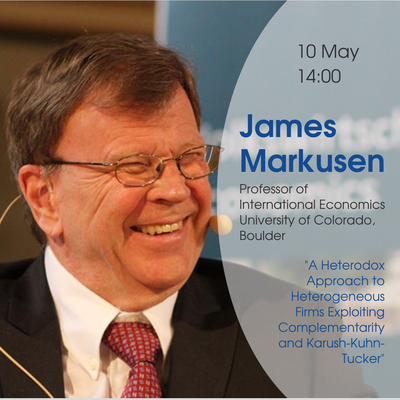10 May 2024
Seminars, Conferences / Workshops, PhD Seminars,
14:00 - 15:00,
Anna Nussbaum, World Trade Institute,
Hallerstrasse 6, Bern, Switzerland
Seminar "A Heterodox Approach to Heterogeneous Firms Exploiting Complementarity and Karush-Kuhn-Tucker"
On Friday, 10 May, we have the pleasure to welcome James R. Markusen, Department of Economics, University of Colorado, Boulder.
Join us for an exciting seminar, this Friday.
James R. Markusen, Professor of International Economics at the University of Colorado, Boulder, will present his latest paper on
"A Heterodox Approach to Heterogeneous Firms Exploiting Complementarity and Karush-Kuhn-Tucker"
Abstract
The now-conventional approach to heterogeneous firms models a continuum of firm “types” within an industry with productivities following a parametric distribution. Here I take a different approach in which there is a discrete and finite set of firm types, differing in marginal costs across but not within types. There is an upper bound on the number of firms that can enter in each firm type. Formulated as a non-linear complementarity problem, we can solve for the set of active firm types in relation to characteristics of the economy such as size or trade costs. Typical limiting assumptions of the existing approach can be dispensed with. (A) the analysis easily incorporates endogenous markups, Nash Cournot or Nash Bertrand, which give data-consistent results about markups. (B) positive aggregate profit income is simple to incorporate in general equilibrium. (C) the (average) productivity of different categories (e.g., quintals) of firms can be calculated directly from data. (D) no integrals/integration/parametric distributions are required. Key properties of the conventional approach are reproduced, such as the sorting toward more productive firms as the economy grows or trade costs fall. I argue that my alternative also has two practical contributions. First, it allows a straightforward way to insert firm heterogeneity or capacity constraints into conventional general-equilibrium simulation models, with no complex added coding. Second, it illustrates a powerful way to deal with “zeros” and regime changes in a broad range of applications (e.g., trade links and sector outputs allowed to change from active to inactive or vice versa, firms choosing exports versus foreign production).
This lecture will take place at the World Trade Institute in Bern, exclusively on-site.
Further info
More about Prof Markusen


